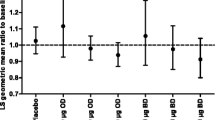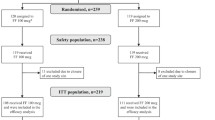Abstract
Objective: To compare the systemic potency of inhaled fluticasone propionate delivered via Diskhaler® (FP-DH), and inhaled budesonide delivered via Turbuhaler® (BUD-TBH) over the clinically recommended dose range using plasma cortisol suppression as a marker for systemic activity.
Methods: The systemic potency was examined in a dose-response study in 81 healthy male volunteers. The study was of an open, randomized, parallel-group (four groups) design, where two treatments were given in crossover fashion within each group. FP-DH and BUD-TBH were given b.i.d. for 7 days (14 doses): 100 and 100 μg (group 1); 200 and 200 μg (group 2); 500 and 400 μg (group 3); 1000 and 800 μg (group 4). There was a washout period of 7 days within each treatment group. All doses were administered at 08:00 and 20:00 hours. Multiple plasma cortisol samples were taken every 2 h over 24-h periods prior to randomization (baseline) and during steady state (i.e., the last two dosing intervals). Cortisol suppression was determined by comparing average plasma concentrations of cortisol before and during treatment. Dose-response curves for cortisol suppression were analyzed using multivariate non-linear regression (Hill modeling).
Results: Multiple dosing for 7 days with FP-DH and BUD-TBH resulted in dose-dependent cortisol suppression by both drugs, most pronounced at the two highest dose levels. FP-DH-induced suppression was 41% at 500 μg and 86% at 1000 μg b.i.d., while that induced by BUD-TBH was 19% at 400 μg and 47% at 800 μg b.i.d. Statistically significant differences were found when comparing the two steroids at these two dose levels. Doses producing 50% of maximum suppression (ED50) were estimated at 833 μg b.i.d. for BUD-TBH and 479 μg b.i.d. for FP-DH. This gave an estimated relative cortisol suppression over the dose range of 1.74:1 (FP-DH:BUD-TBH). ED50 values, estimated from cortisol concentrations at 08:00 hours (12 h after the last dose), were 1212 μg b.i.d. for BUD-TBH and 527 μg b.i.d. for FP-DH giving a relative cortisol suppression of 2.30:1 (FP-DH:BUD-TBH). Fourteen subjects on the highest FP-DH dose and 3 at the next highest dose had morning plasma cortisol levels below the lower reference limit. No subject taking budesonide, however, had morning plasma cortisol levels below the reference limit. Analysis of the time for return to pretreatment baseline levels showed that cortisol suppression, 12–24 h after the last dose, was statistically significant compared with the baseline for the highest dose of FP-DH but not for any of the BUD-TBH doses.
Conclusions: The results of the present study show that FP-DH suppresses plasma cortisol more than BUD-TBH on a equivalent basis with regard to both magnitude and duration.
Similar content being viewed by others
Author information
Authors and Affiliations
Additional information
Received: 12 August 1996 / Accepted in revised form: 21 January 1997
Rights and permissions
About this article
Cite this article
Grahnén, A., Jansson, B., Brundin, R. et al. A dose-response study comparing suppression of plasma cortisol induced by fluticasone propionate from Diskhaler and budesonide from Turbuhaler. E J Clin Pharmacol 52, 261–267 (1997). https://doi.org/10.1007/s002280050287
Issue Date:
DOI: https://doi.org/10.1007/s002280050287




